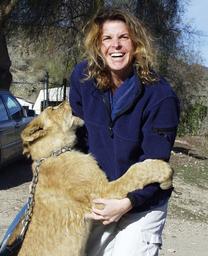
Dr. Jennifer Conrad has cared for wildlife on six continents for over two decades. She is an impassioned advocate for animal welfare, who has seen first-hand the suffering and exploitation of animals, destruction of habitat, and gratuitous hunting — all of which threaten the welfare and very survival of many species. Dr. Conrad has participated in many programs to protect and improve the lives of wild animals. She has traveled to Namibia to de-horn rhinos, making them unattractive targets for slaughter by poachers who prize the horns for ornamental uses. While in Africa, she worked with the Cheetah Conservation Fund, collecting information to help fortify the dwindling numbers of this species. In Nepal, Dr. Conrad treated endangered Asian elephants, and in the Galapagos Islands, she joined government scientists treating a threatened population of sea lions.
Dr. Conrad is a graduate of the University of California, Davis, School of Veterinary Medicine and is a member of the American Veterinary Medicine Association (AVMA), the American Association of Zoo Veterinarians (AAZV), and the European Association of Zoo and Wildlife Veterinarians (EAZWV).
Currently, Dr. Conrad’s professional responsibilities are divided between working with nonprofit wildlife sanctuaries for unwanted and abused animals in southern California and administering her own company, Vet to the (Real) Stars, which provides humane veterinary care to animals appearing in television and movies. Some of her animal actors have appeared in The Life of Pi, Transformers II, The Hangover, Zoo Keeper, Doctor Doolittle 2 and The Planet of the Apes.
In her former role as head veterinarian at a wildlife sanctuary, Dr. Conrad founded the Paw Project, which rehabilitates big cats, such as lions, tigers, cougars and jaguars maimed by declawing. Actually an amputation of the last bone in the cat’s toe, declawing often cripples these magnificent creatures, both from the pain caused by the bone fragments left behind, and from the progressively debilitating arthritis produced by abnormal stress on other joints as the cats try to avoid walking on their painful, amputated toes.

